
Allium vineale is a perennial, bulb-forming species of wild onion, native to Europe, northwestern Africa and the Middle East. The species was introduced in Australia and North America, where it has become a noxious weed.
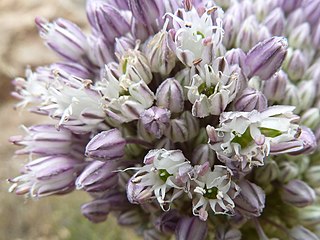
Allium ampeloprasum is a member of the onion genus Allium. The wild plant is commonly known as wild leek or broadleaf wild leek. Its native range is southern Europe to western Asia, but it is cultivated in many other places and has become naturalized in many countries.
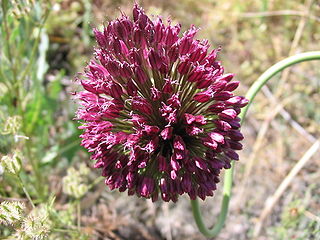
Allium sphaerocephalon is a plant species in the Amaryllis family known as round-headed leek, round-headed garlic, ball-head onion, and other variations on these names. Drumstick allium is another common name applied to this species. Some publications use the alternate spelling Allium sphaerocephalum. It is a bulbous herbaceous perennial plant.

Allium unifolium, the one-leaf onion or American garlic, is a North American species of wild onion. It is native to the coastal mountain ranges of California, Oregon, and Baja California. It grows on clay soils including serpentine, at elevations up to 1100 m.
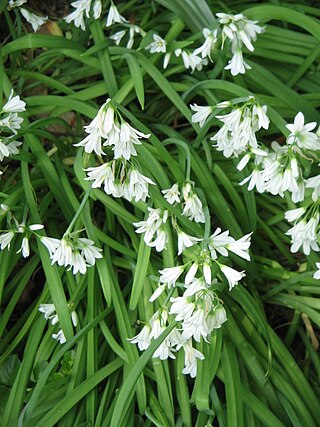
Allium triquetrum is a bulbous flowering plant in the genus Allium native to the Mediterranean basin. It is known in English as three-cornered leek, in Australia as angled onion and in New Zealand as onion weed. Both the English name and the specific epithet triquetrum refer to the three-cornered shape of the flower stalks.

Allium acuminatum, also known as the tapertip onion or Hooker's onion, is a species in the genus Allium native to North America.

Allium peninsulare is a North American species of wild onion. It is known by such common names as Mexicali onion and Peninsula onion; the former referring to the Mexican city just south of the US/Mexican border, the latter referring to the Peninsula of Baja California. It is widespread in California, USA, where it grows in the California Coast Ranges, Sierra Nevada foothills, some of the Channel Islands, and Peninsular Ranges. The range extends south into the northernmost part of Baja California and north into southern Oregon.
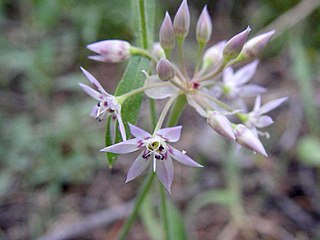
Allium campanulatum is a species of wild onion known by the common name dusky onion or Sierra onion. This is a flowering plant native to the western United States from southeastern Washington and northern Oregon to southern California, and western Nevada. The dusky onion grows in foothills and mountains, especially in dry areas, such as chaparral habitats.

Allium obtusum is a species of wild onion known by the common name red Sierra onion or subalpine onion. It is native to eastern California and western Nevada. It is a common plant in the granite foothills and mountains of the Sierra Nevada and southern Cascade Range, from Tulare County to Siskiyou County, from elevations of 800 to 3,500 metres. In Nevada, it is reported only from Washoe County in the northwestern part of the state.
Allium bolanderi is a species of wild onion known by the common name Bolander's onion. It is native to northern California and southwestern Oregon, where it grows in the rocky soils of the Klamath Mountains and surrounding regions.

Allium cratericola is a species of wild onion known by the common name Cascade onion. It is endemic to California, where is an uncommon member of the flora in several of the state's mountain ranges, including the northern and southern California Coast Ranges, the western Transverse Ranges, Klamath Mountains, and the Sierra Nevada foothills. Its range covers much of the state, from Riverside County to Siskiyou County.
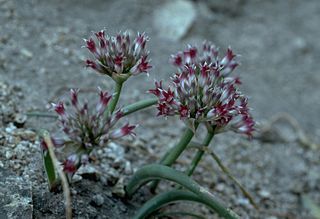
Allium monticola is an uncommon species of wild onion known by the common name San Bernardino Mountain onion. It is endemic to southern California, where it is found in the Transverse Ranges and the northernmost section of the Peninsular Ranges. It has been reported from San Bernardino, Los Angeles, Orange, Ventura and Santa Barbara Counties.

Allium praecox is a species of wild onion known by the common name early onion.
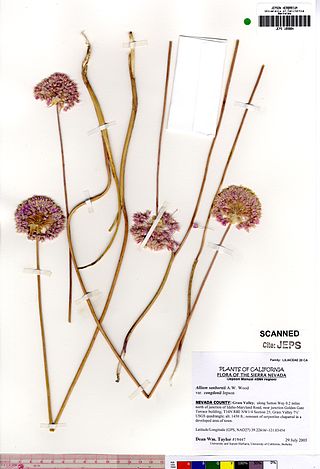
Allium sanbornii is a North American species of wild onion known by the common name Sanborn's onion. It is native to northern California and southwestern Oregon. It grows in the serpentine soils of the southern Cascade Range and northern Sierra Nevada foothills.

Allium siskiyouense is a North American species of wild onion known by the common name Siskiyou onion. It is native to the Klamath Mountains and nearby ranges of northern California and Oregon. It grows in serpentine and other rocky soil types.

Allium tribracteatum, known by the common name Threebract onion, is a species of wild onion found in California.

Allium bisceptrum, also known as the twincrest onion or aspen onion, is a high elevation plant native to western United States. It is a perennial that thrives under damp and shady conditions or open meadows in California, Arizona, New Mexico, Nevada, Oregon, Washington, Idaho, and Utah.
Allium plummerae is a species of plant native to southern Arizona in the United States and to Sonora in Mexico. It is known by the common names Plummer's onion and Tanner's Canyon onion. It grows on rocky slopes and stream banks in mountains regions at elevations of 1600–2800 m.
Allium sharsmithiae, called the Mount Hamilton onion or Helen Sharsmith's onion, is a rare species of wild onion endemic to a small region in California. It is found on serpentine soils in the vicinity of Mount Hamilton, in the Diablo Range south of San Francisco Bay in Santa Clara, Alameda and Stanislaus Counties.

Allium crenulatum, common name Olympic onion, is a plant species native to Oregon, Washington, and British Columbia. It grows in the Cascades, the Coast Ranges, the Olympic Mountains, the Wenatchee Mountains, and the mountains on Vancouver Island. There is one report from Alabama, but this needs verification. The species grows on talus slopes and in alpine tundra at elevations of 600–2500 m.



















